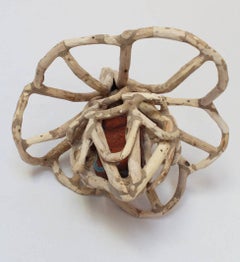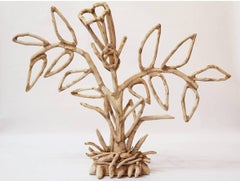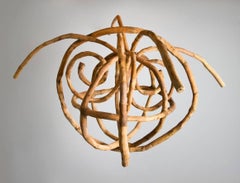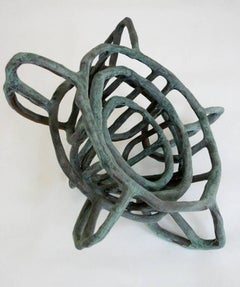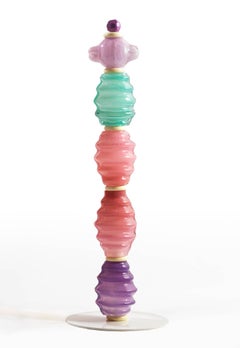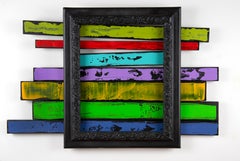ODETTA
to
10
10
41
41
34
32
32
Creator: Loren Eiferman
Loren Eiferman, Nature Will Heal, 108 Pieces of Wood, 2016, Wood, Found Objects
By Loren Eiferman
Located in Darien, CT
Over many decades Loren Eiferman has created and mastered a unique technique of working with wood—her primary material.
First, she begins with a drawing of an idea. Then she takes a daily walk in the woods surrounding her studio and collects tree limbs and long sticks that have fallen to the ground. She never chops down a living tree or uses green wood. Eiferman allows the wood time to cure in the studio to make sure it won’t check or crack.
Next, she debarks the branch and looks for shapes found within each piece of wood. Using a Japanese hand saw, she cuts and connect these small shapes together using dowels and wood glue. Then, all the open joints get filled with a home made putty, which is then sanded so she can see the newly formed shapes. This process is until the new sculpture appears like the original line drawing but in space. She wants the work to appear as if it grew in nature, when in fact each sculpture is composed of over 100 small pieces of wood that are seamlessly jointed together. Her work can be called the ultimate recycling: taking the detritus of nature and giving it a new life.
We have all at one point or another picked up a stick from the ground—touched the wood, peeled the bark off with our fingernails. Her work taps into that same primal desire of touching nature and being close to it. Trees connect us back to nature, back to this Earth. Her work has a meditative quality to it—a quiet, calming energy.
Her influences are many; from looking at nature and plant life on this Earth to researching the heavenly bodies in the images beamed back from the Hubble Telescope. From studying ancient Buddhist mandalas and designs to delving deeper into quantum physics. And from researching mysterious manuscripts to studying the patterns inside our brains.
For Invocation, we are exhibiting her newest body of work, inspired by the illustrations found in the Voynich Manuscript. This 250-page book, is believed to have been written in the early 15th century, of a mysterious origin and purpose.
Written in an unknown language and currently housed at Yale University’s Beinecke Rare Book Library, the manuscript has eluded all attempts in the intervening centuries to decode or decipher its purpose and meaning. This enigmatic book is divided into 6 different sections (herbal, astronomical, biological, cosmological, pharmaceutical and recipes).
Having discovered the images contained in this codex over the Internet, Eiferman felt an immediate, profound and inexplicable connection to this manuscript and its creator.
The artist is currently transposing the “herbal” section of manuscript into sculptures. This section has drawings in it of plants and flowers that do not really exist in nature—past or present. These aren’t just pretty images of flowers—they also contain the wacky root systems and seemingly out of proportion leaves, stamens and pistils.
Loren Eiferman was born in Brooklyn, NY. She received her BFA from SUNY Purchase. Her work has been exhibited extensively throughout the Tri-State region including gallery and museum exhibitions in the Hudson Valley and Connecticut. Her work is included in numerous corporate and private art collections.
In 2014 she was awarded a NYC MTA Arts & Design art commission to produce steel railings...
Category
2010s Abstract Abstract Sculptures
Materials
Wood, Found Objects
Loren Eiferman, 2V, 180 Pieces of Wood with Celluclay, 2015, Polymer, Wood, Clay
By Loren Eiferman
Located in Darien, CT
Over many decades Loren Eiferman has created and mastered a unique technique of working with wood—her primary material.
First, she begins with a drawing of an idea. Then she takes...
Category
2010s Abstract Abstract Sculptures
Materials
Clay, Wood, Polymer
Loren Eiferman, 1v, 151 Pieces of Wood, 2016, Wood Sculpture
By Loren Eiferman
Located in Darien, CT
Over many decades Loren Eiferman has created and mastered a unique technique of working with wood—her primary material.
First, she begins with a drawing of an idea. Then she takes a daily walk in the woods surrounding her studio and collects tree limbs and long sticks that have fallen to the ground. She never chops down a living tree or uses green wood. Eiferman allows the wood time to cure in the studio to make sure it won’t check or crack.
Next, she debarks the branch and looks for shapes found within each piece of wood. Using a Japanese hand saw, she cuts and connect these small shapes together using dowels and wood glue. Then, all the open joints get filled with a home made putty, which is then sanded so she can see the newly formed shapes. This process is until the new sculpture appears like the original line drawing but in space. She wants the work to appear as if it grew in nature, when in fact each sculpture is composed of over 100 small pieces of wood that are seamlessly jointed together. Her work can be called the ultimate recycling: taking the detritus of nature and giving it a new life.
We have all at one point or another picked up a stick from the ground—touched the wood, peeled the bark off with our fingernails. Her work taps into that same primal desire of touching nature and being close to it. Trees connect us back to nature, back to this Earth. Her work has a meditative quality to it—a quiet, calming energy.
Her influences are many; from looking at nature and plant life on this Earth to researching the heavenly bodies in the images beamed back from the Hubble Telescope. From studying ancient Buddhist mandalas and designs to delving deeper into quantum physics. And from researching mysterious manuscripts to studying the patterns inside our brains.
For Invocation, we are exhibiting her newest body of work, inspired by the illustrations found in the Voynich Manuscript. This 250-page book, is believed to have been written in the early 15th century, of a mysterious origin and purpose.
Written in an unknown language and currently housed at Yale University’s Beinecke Rare Book Library, the manuscript has eluded all attempts in the intervening centuries to decode or decipher its purpose and meaning. This enigmatic book is divided into 6 different sections (herbal, astronomical, biological, cosmological, pharmaceutical and recipes).
Having discovered the images contained in this codex over the Internet, Eiferman felt an immediate, profound and inexplicable connection to this manuscript and its creator.
The artist is currently transposing the “herbal” section of manuscript into sculptures. This section has drawings in it of plants and flowers that do not really exist in nature—past or present. These aren’t just pretty images of flowers—they also contain the wacky root systems and seemingly out of proportion leaves, stamens and pistils.
Loren Eiferman was born in Brooklyn, NY. She received her BFA from SUNY Purchase. Her work has been exhibited extensively throughout the Tri-State region including gallery and museum exhibitions in the Hudson Valley and Connecticut. Her work is included in numerous corporate and private art collections.
In 2014 she was awarded a NYC MTA Arts & Design art commission to produce steel railings...
Category
2010s Abstract Abstract Sculptures
Materials
Wood, Putty
Loren Eiferman, Calabi-Yau, 165 wood pieces, 2013, Wood, Putty, Wood Sculpture
By Loren Eiferman
Located in Darien, CT
Over many decades Loren Eiferman has created and mastered a unique technique of working with wood—her primary material.
First, she begins with a drawing of an idea. Then she take...
Category
2010s Abstract Abstract Sculptures
Materials
Wood, Putty
Loren Eiferman, Galaxy, 129 Pieces of Wood, 2012, Wood, Putty, Wood Sculpture
By Loren Eiferman
Located in Darien, CT
Over many decades Loren Eiferman has created and mastered a unique technique of working with wood—her primary material.
First, she begins with a drawing of an idea. Then she takes a daily walk in the woods surrounding her studio and collects tree limbs and long sticks that have fallen to the ground. She never chops down a living tree or uses green wood. Eiferman allows the wood time to cure in the studio to make sure it won’t check or crack.
Next, she debarks the branch and looks for shapes found within each piece of wood. Using a Japanese hand saw, she cuts and connect these small shapes together using dowels and wood glue. Then, all the open joints get filled with a home made putty, which is then sanded so she can see the newly formed shapes. This process is until the new sculpture appears like the original line drawing but in space. She wants the work to appear as if it grew in nature, when in fact each sculpture is composed of over 100 small pieces of wood that are seamlessly jointed together. Her work can be called the ultimate recycling: taking the detritus of nature and giving it a new life.
We have all at one point or another picked up a stick from the ground—touched the wood, peeled the bark off with our fingernails. Her work taps into that same primal desire of touching nature and being close to it. Trees connect us back to nature, back to this Earth. Her work has a meditative quality to it—a quiet, calming energy.
Her influences are many; from looking at nature and plant life on this Earth to researching the heavenly bodies in the images beamed back from the Hubble Telescope. From studying ancient Buddhist mandalas and designs to delving deeper into quantum physics. And from researching mysterious manuscripts to studying the patterns inside our brains.
For Invocation, we are exhibiting her newest body of work, inspired by the illustrations found in the Voynich Manuscript. This 250-page book, is believed to have been written in the early 15th century, of a mysterious origin and purpose.
Written in an unknown language and currently housed at Yale University’s Beinecke Rare Book Library, the manuscript has eluded all attempts in the intervening centuries to decode or decipher its purpose and meaning. This enigmatic book is divided into 6 different sections (herbal, astronomical, biological, cosmological, pharmaceutical and recipes).
Having discovered the images contained in this codex over the Internet, Eiferman felt an immediate, profound and inexplicable connection to this manuscript and its creator.
The artist is currently transposing the “herbal” section of manuscript into sculptures. This section has drawings in it of plants and flowers that do not really exist in nature—past or present. These aren’t just pretty images of flowers—they also contain the wacky root systems and seemingly out of proportion leaves, stamens and pistils.
Loren Eiferman was born in Brooklyn, NY. She received her BFA from SUNY Purchase. Her work has been exhibited extensively throughout the Tri-State region including gallery and museum exhibitions in the Hudson Valley and Connecticut. Her work is included in numerous corporate and private art collections.
In 2014 she was awarded a NYC MTA Arts & Design art commission to produce steel railings...
Category
2010s Abstract Abstract Sculptures
Materials
Putty, Wood
Loren Eiferman, Satellite, 2010, 125 pieces of wood, copper, patina
By Loren Eiferman
Located in Darien, CT
Over many decades Loren Eiferman has created and mastered a unique technique of working with wood—her primary material.
First, she begins with a drawing of an idea. Then she take...
Category
2010s Abstract Abstract Sculptures
Materials
Copper
Loren Eiferman, Voynich #1, 124 Pieces of Wood, 2015, Wood, Putty, 54x30x20 in
By Loren Eiferman
Located in Darien, CT
Over many decades Loren Eiferman has created and mastered a unique technique of working with wood—her primary material.
First, she begins with a drawing of an idea. Then she takes a daily walk in the woods surrounding her studio and collects tree limbs and long sticks that have fallen to the ground. She never chops down a living tree or uses green wood. Eiferman allows the wood time to cure in the studio to make sure it won’t check or crack.
Next, she debarks the branch and looks for shapes found within each piece of wood. Using a Japanese hand saw, she cuts and connect these small shapes together using dowels and wood glue. Then, all the open joints get filled with a home made putty, which is then sanded so she can see the newly formed shapes. This process is until the new sculpture appears like the original line drawing but in space. She wants the work to appear as if it grew in nature, when in fact each sculpture is composed of over 100 small pieces of wood that are seamlessly jointed together. Her work can be called the ultimate recycling: taking the detritus of nature and giving it a new life.
We have all at one point or another picked up a stick from the ground—touched the wood, peeled the bark off with our fingernails. Her work taps into that same primal desire of touching nature and being close to it. Trees connect us back to nature, back to this Earth. Her work has a meditative quality to it—a quiet, calming energy.
Her influences are many; from looking at nature and plant life on this Earth to researching the heavenly bodies in the images beamed back from the Hubble Telescope. From studying ancient Buddhist mandalas and designs to delving deeper into quantum physics. And from researching mysterious manuscripts to studying the patterns inside our brains.
For Invocation, we are exhibiting her newest body of work, inspired by the illustrations found in the Voynich Manuscript. This 250-page book, is believed to have been written in the early 15th century, of a mysterious origin and purpose.
Written in an unknown language and currently housed at Yale University’s Beinecke Rare Book Library, the manuscript has eluded all attempts in the intervening centuries to decode or decipher its purpose and meaning. This enigmatic book is divided into 6 different sections (herbal, astronomical, biological, cosmological, pharmaceutical and recipes).
Having discovered the images contained in this codex over the Internet, Eiferman felt an immediate, profound and inexplicable connection to this manuscript and its creator.
The artist is currently transposing the “herbal” section of manuscript into sculptures. This section has drawings in it of plants and flowers that do not really exist in nature—past or present. These aren’t just pretty images of flowers—they also contain the wacky root systems and seemingly out of proportion leaves, stamens and pistils.
Loren Eiferman was born in Brooklyn, NY. She received her BFA from SUNY Purchase. Her work has been exhibited extensively throughout the Tri-State region including gallery and museum exhibitions in the Hudson Valley and Connecticut. Her work is included in numerous corporate and private art collections.
In 2014 she was awarded a NYC MTA Arts & Design art commission to produce steel railings...
Category
2010s Abstract Still-life Sculptures
Materials
Wood, Putty
Loren Eiferman, Winter Solstice, 2012, 165 Pieces of Wood, Putty, Wood Sculpture
By Loren Eiferman
Located in Darien, CT
Over many decades Loren Eiferman has created and mastered a unique technique of working with wood—her primary material.
First, she begins with a drawing of an idea. Then she takes a daily walk in the woods surrounding her studio and collects tree limbs and long sticks that have fallen to the ground. She never chops down a living tree or uses green wood. Eiferman allows the wood time to cure in the studio to make sure it won’t check or crack.
Next, she debarks the branch and looks for shapes found within each piece of wood. Using a Japanese hand saw, she cuts and connect these small shapes together using dowels and wood glue. Then, all the open joints get filled with a home made putty, which is then sanded so she can see the newly formed shapes.
This process is until the new sculpture appears like the original line drawing but in space. She wants the work to appear as if it grew in nature, when in fact each sculpture is composed of over 100 small pieces of wood that are seamlessly jointed together.
Her work can be called the ultimate recycling: taking the detritus of nature and giving it a new life. We have all at one point or another picked up a stick from the ground—touched the wood, peeled the bark off with our fingernails. Her work taps into that same primal desire of touching nature and being close to it. Trees connect us back to nature, back to this Earth. Her work has a meditative quality to it—a quiet, calming energy.
Her influences are many; from looking at nature and plant life on this Earth to researching the heavenly bodies in the images beamed back from the Hubble Telescope. From studying ancient Buddhist mandalas and designs to delving deeper into quantum physics. And from researching mysterious manuscripts to studying the patterns inside our brains.
Her newest body of work is inspired by the illustrations found in the Voynich Manuscript. This 250-page book, is believed to have been written in the early 15th century, of a mysterious origin and purpose.
Written in an unknown language and currently housed at Yale University’s Beinecke Rare Book Library, the manuscript has eluded all attempts in the intervening centuries to decode or decipher its purpose and meaning. This enigmatic book is divided into 6 different sections (herbal, astronomical, biological, cosmological, pharmaceutical and recipes).
Having discovered the images contained in this codex over the Internet, Eiferman felt an immediate, profound and inexplicable connection to this manuscript and its creator.
The artist is currently transposing the “herbal” section of manuscript into sculptures. This section has drawings in it of plants and flowers that do not really exist in nature—past or present. These aren’t just pretty images of flowers—they also contain the wacky root systems and seemingly out of proportion leaves, stamens and pistils.
Loren Eiferman was born in Brooklyn, NY. She received her BFA from SUNY Purchase.
Her work has been exhibited extensively throughout the Tri-State region including gallery and museum exhibitions in the Hudson Valley and Connecticut.
Her work is included in numerous corporate and private art collections.
In 2014 she was awarded a NYC MTA Arts & Design art commission to produce steel railings...
Category
2010s Abstract Abstract Sculptures
Materials
Wood, Putty
Loren Eiferman, 5r, 146 Pieces of Wood with Rope and Wax, 2016, Wood Sculpture
By Loren Eiferman
Located in Darien, CT
Over many decades Loren Eiferman has created and mastered a unique technique of working with wood—her primary material.
First, she begins with a drawing of an idea. Then she takes...
Category
2010s Abstract Abstract Sculptures
Materials
Wood
Loren Eiferman, 14 V, 2017, 94 Pieces of Wood, 48 x 22 x 18 in, wood sculpture
By Loren Eiferman
Located in Darien, CT
Over many decades Loren Eiferman has created and mastered a unique technique of working with wood—her primary material.
First, she begins with a drawing of an idea. Then she takes a daily walk in the woods surrounding her studio and collects tree limbs and long sticks that have fallen to the ground. She never chops down a living tree or uses green wood. Eiferman allows the wood time to cure in the studio to make sure it won’t check or crack.
Next, she debarks the branch and looks for shapes found within each piece of wood. Using a Japanese hand saw, she cuts and connect these small shapes together using dowels and wood glue. Then, all the open joints get filled with a home made putty, which is then sanded so she can see the newly formed shapes. This process is until the new sculpture appears like the original line drawing but in space. She wants the work to appear as if it grew in nature, when in fact each sculpture is composed of over 100 small pieces of wood that are seamlessly jointed together. Her work can be called the ultimate recycling: taking the detritus of nature and giving it a new life.
We have all at one point or another picked up a stick from the ground—touched the wood, peeled the bark off with our fingernails. Her work taps into that same primal desire of touching nature and being close to it. Trees connect us back to nature, back to this Earth. Her work has a meditative quality to it—a quiet, calming energy.
Her influences are many; from looking at nature and plant life on this Earth to researching the heavenly bodies in the images beamed back from the Hubble Telescope. From studying ancient Buddhist mandalas and designs to delving deeper into quantum physics. And from researching mysterious manuscripts to studying the patterns inside our brains.
For Invocation, we are exhibiting her newest body of work, inspired by the illustrations found in the Voynich Manuscript. This 250-page book, is believed to have been written in the early 15th century, of a mysterious origin and purpose.
Written in an unknown language and currently housed at Yale University’s Beinecke Rare Book Library, the manuscript has eluded all attempts in the intervening centuries to decode or decipher its purpose and meaning. This enigmatic book is divided into 6 different sections (herbal, astronomical, biological, cosmological, pharmaceutical and recipes).
Having discovered the images contained in this codex over the Internet, Eiferman felt an immediate, profound and inexplicable connection to this manuscript and its creator.
The artist is currently transposing the “herbal” section of manuscript into sculptures. This section has drawings in it of plants and flowers that do not really exist in nature—past or present. These aren’t just pretty images of flowers—they also contain the wacky root systems and seemingly out of proportion leaves, stamens and pistils.
Loren Eiferman was born in Brooklyn, NY. She received her BFA from SUNY Purchase. Her work has been exhibited extensively throughout the Tri-State region including gallery and museum exhibitions in the Hudson Valley and Connecticut. Her work is included in numerous corporate and private art collections.
In 2014 she was awarded a NYC MTA Arts & Design art commission to produce steel railings...
Category
2010s Abstract Abstract Sculptures
Materials
Wood
Related Items
Lantern Column I
By Niho Kozuru
Located in West Palm Beach, FL
Title: Lantern Column I
Year: 1998 - 2014
Medium: Mold blown glass, cast polymer, steel, cast iron
Size: 41 3/4" inches
Niho Kozuru (髙鶴丹穂) is a Japanese-born mixed media artist based in Boston, MA. Kozuru casts and reconfigures molds of her own designs, classical and industrial turned architectural forms in unexpected materials. Using rubber, glass and clay she creates columns with undulating silhouettes.
The “Lantern Columns” are a group of 7 towers, ranging from 4 feet to 7 feet tall. They have been shown in various configurations in multiple US States as well as the Fukuoka City Museum in Kyushu, Japan. Kozuru made 60 components by blowing glass into molds of her own designs while at Artists in Residency at Penland School of Crafts in North Carolina.
After traveling the world, the Lantern Columns have been arranged into their final configuration, with a steel armature within and each topped with a vivid cast iron final...
Category
2010s Abstract More Art
Materials
Steel, Iron
"The Bigger Picture", abstract sculpture, found frame, wood, paint, geometry
Located in Toronto, Ontario
"The Bigger Picture" is an abstract artwork by Stan Olthuis composed of acrylic paint on pine wood and reclaimed picture frame. The Bigger Picture measures...
Category
21st Century and Contemporary Abstract Geometric Abstract Sculptures
Materials
Acrylic, Wood, Found Objects
Leslie (Flowers Series) - modern, abstract, contemporary, fiberglass sculpture
By Benny Katz
Located in Bloomfield, ON
Funky and fun, this glossy, brightly coloured sculpture by Benny Katz is a contemporary ‘take’ on a bouquet of flowers. To create his ‘flower series’ the Israel-based artist has used...
Category
2010s Contemporary Abstract Sculptures
Materials
Metal
Ceramic 13, Japanese Ceramic Sculpture by Yasuhisa Kohyama
By Yasuhisa Kohyama
Located in Wilton, CT
Yasuhisa Kohyama shapes his asymmetrical forms using piano wire, creating distinctive rough surfaces. The clay with its feldspar nuggets creates a tac...
Category
Early 2000s Abstract Abstract Sculptures
Materials
Ceramic, Clay
H 14.9 in W 10.6 in D 6.3 in
Lantern Column IV- Blown Glass 60 inches High
By Niho Kozuru
Located in West Palm Beach, FL
Title: Lantern Column IV
Year: 1998 - 2014
Medium: Mold blown glass, cast polymer, steel, cast iron
Size: 60 3/4 inches
Price: $10,000.
Niho Kozuru (髙鶴丹穂) is a Japanese-born mixed media artist based in Boston, MA. Kozuru casts and reconfigures molds of her own designs, classical and industrial turned architectural forms in unexpected materials. Using rubber, glass and clay she creates columns with undulating silhouettes.
The “Lantern Columns” are a group of 7 towers, ranging from 4 feet to 7 feet tall. They have been shown in various configurations in multiple US States as well as the Fukuoka City Museum in Kyushu, Japan. Kozuru made 60 components by blowing glass into molds of her own designs while at Artists in Residency at Penland School of Crafts in North Carolina.
After traveling the world, the Lantern Columns have been arranged into their final configuration, with a steel armature within and each topped with a vivid cast iron final...
Category
2010s Abstract Abstract Sculptures
Materials
Steel, Iron
Sai, Japanese Ceramic Sculpture by Yasuhisa Kohyama
By Yasuhisa Kohyama
Located in Wilton, CT
Yasuhisa Kohyama shapes his asymmetrical forms using piano wire, creating distinctive rough surfaces. The clay with its feldspar nuggets creates a tac...
Category
2010s Abstract Abstract Sculptures
Materials
Ceramic, Clay
H 14.5 in W 13 in D 3.25 in
Willow Wave Basket
Located in Wilton, CT
Wood was integral to the artistic practice of the late Markku Kosonen of Finland. An important aspect of his work was the ability to express things; cra...
Category
1990s Abstract Abstract Sculptures
Materials
Organic Material, Wood, Found Objects
Bedfellows
Located in Lincoln, RI
Bedfellows refers to partnerships and celebrates relationships. This piece is subtle and beautiful. The pale, purple paint accentuates the carved texture. The piece is framed in wh...
Category
2010s Abstract Abstract Paintings
Materials
Plaster, Wood, Maple, Acrylic
Hajibito (Ceramic 53), by Yasuhisa Kohyama
By Yasuhisa Kohyama
Located in Wilton, CT
Yasuhisa Kohyama shapes his asymmetrical forms using piano wire, creating distinctive rough surfaces. The clay with its feldspar nuggets creates a tac...
Category
1990s Abstract Abstract Sculptures
Materials
Ceramic, Clay
Ocean - small stacked sculpture of white ovals, with blue and green highlights
By Benny Katz
Located in Bloomfield, ON
In stacked glossy ovals of white, highlighted in blue and green, Israeli-based sculptor Benny Katz creates the playful essence of a ocean waves. This work is number 2 in an edition ...
Category
2010s Contemporary Abstract Sculptures
Materials
Metal
'Corn Eggshell Effect'
Located in Valencia, ES
Made in Spain, 2023.
Pure symbolism and collaboration of clay and natural wood make this series of sculptures ideal for table or floor-pedestal installation in the office, bedroom, ...
Category
2010s Abstract Abstract Sculptures
Materials
Clay, Varnish, Acrylic, Wood
Lantern Column VI
By Niho Kozuru
Located in West Palm Beach, FL
Title: Lantern Column VI
Year: 1998 - 2014
Medium: Mold blown glass, cast polymer, steel, cast iron
Size: 69 1/2 inches
Price: $11,000.
Niho Kozuru (髙鶴丹穂) is a Japanese-born mixed media artist based in Boston, MA. Kozuru casts and reconfigures molds of her own designs, classical and industrial turned architectural forms in unexpected materials. Using rubber, glass and clay she creates columns with undulating silhouettes.
The “Lantern Columns” are a group of 7 towers, ranging from 4 feet to 7 feet tall. They have been shown in various configurations in multiple US States as well as the Fukuoka City Museum in Kyushu, Japan. Kozuru made 60 components by blowing glass into molds of her own designs while at Artists in Residency at Penland School of Crafts in North Carolina.
After traveling the world, the Lantern Columns have been arranged into their final configuration, with a steel armature within and each topped with a vivid cast iron final...
Category
2010s Abstract More Art
Materials
Steel, Iron
